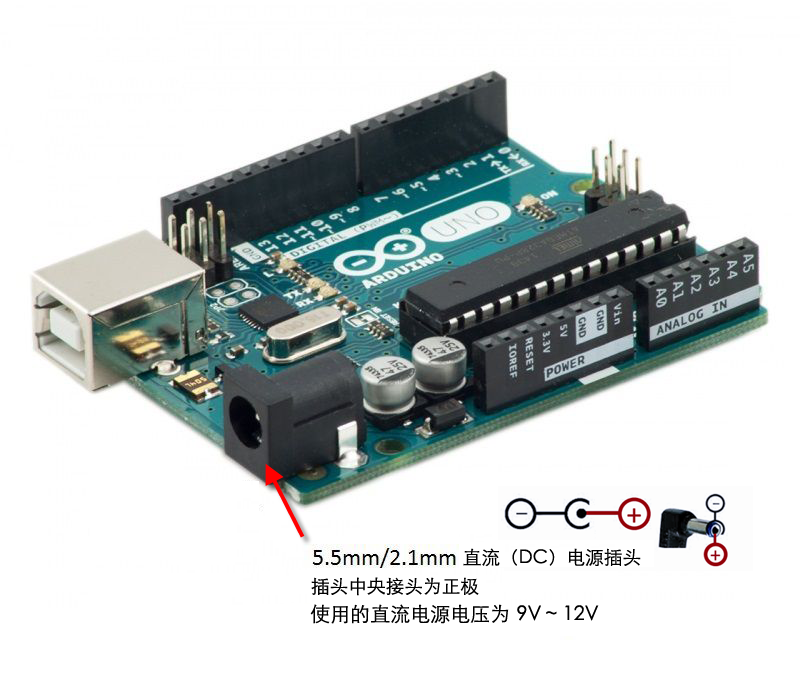

Also, with no diode, there is also no voltage drop. What you don’t have on the Vin pin is any reverse polarity protection – because there is no diode protection there – so you’ll want to make sure to connect positive voltage to this pin. The voltage requirement is the same as with the DC jack, because you’ll notice Vin is supplying power to the 5V regulator as well – in fact powering with Vin is almost exactly like powering with the DC jack. Vin is a pin on the Arduino power rail where you can directly hook a power supply line into the board. If you use the DC jack, you may want to bump up the input voltage a bit. If you provide the DC jack with 7 volts, the 5V regulator will see an input of 7V – 0.7V = 6.3 V, which is getting uncomfortably close to the minimum 5V regulator input of 6.2V. There’s one more important thing to mention: the diode in line with the DC jack has a voltage drop of roughly 0.7 volts. Notice that the 5V regulated power supply also power the 3.3V regulator on the board, which then provides power to the 3.3V pin.

So if you go attaching a bunch of stuff to your 5V power rail that draws a bunch of current, like say servos that are going to be under a high load, then you’ll be drawing more current than what the regulator is rated for, and you’ll burn up the part – something you’d want to avoid. In fact, the components on the Arduino UNO board itself will be using around 25mA of current. What’s the big deal about the current? Well here is the deal – all the electronics stuff you attach to your Arduino board is going to consume current. OK – one more thing about that 5V regulator, it can provide up to 1A of current.
#ARDUINO UNO 12V POWER SUPPLY HOW TO#
We are developing an entire course on powering Arduino, and how to think about your current inventory – it’s currently in production – if you want to learn more about what we offer check out our courses page. Now, there’s a lot of details here I am going over rather quickly.

But just in case you accidentally use a center negative plug and reverse the polarity – the circuit has a diode that protects against that. It important that the plug you use is center positive. The DC jack is 2.1mm center-positive plug. The sweet spot is more like 7-12 volts, if your power supply is much higher than that, you’re wasting a lot of power on that 5V regulator in the form of heat dissipation. The 5V regulator requires a min input voltage of 6.2 volts and can take a maximum input voltage of 20V – so the power supply you hook up to your DC jack needs to be in that range for voltage. What’s so special about 5V? Well 5V is right in the range the microcontrollers on the Arduino board need in order to operate.

Let’s say you hook up a wall wort power supply, or a battery pack to that DC jack – what happens? Per the diagram you can see it powers the 5V regulator on the board. Let’s start with powering an Arduino with the DC jack. In between we have some components that I’ll explain shortly. On the right side we have the 5V and 3.3V pins. And for the “VIN PIN”, that just the hole marked Vin on the power rail of an Arduino Board. When you see “USB PORT”, just imagine that’s where you plug your USB cable in, for “DC JACK” – imagine that where you plug your DC Jack in. It seems like a lot going on – to simplify this a bit further we’ll reduce it down to this block diagram. We are going to use the Arduino UNO schematic to inform our discussion – we’ll be looking at the power section. In our discussion here, we are going to use an Arduino UNO as the base example – much of what we cover can be extended to other common Arduino boards, but in each case you’ll need to double check for your specific model. In this lesson we are going to talk about three ways to power Arduino boards, namely the…Įach method has some quirks and limits you should be aware of, and we’ll do our best to highlight each!


 0 kommentar(er)
0 kommentar(er)
